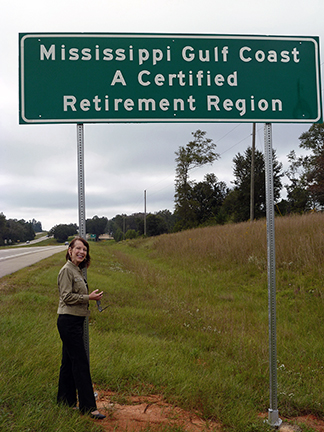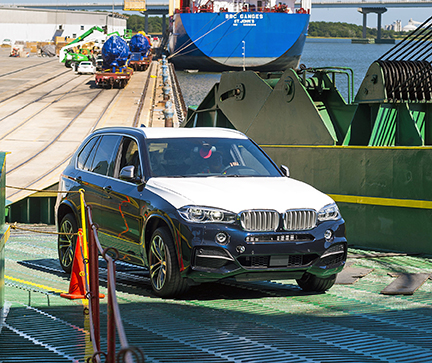 With great irony, free trade devastated the blue jean manufacturing industry in the South in the 1990s and now protectionism (tariffs) may be the one policy that will kill it off for good. On December 31, 2017, Cone Mill’s White Oak Plant in Greensboro, N.C. — the last selvedge denim mill in the U.S. — closed permanently. The White Oak plant opened in 1905 and was, at one point, the largest blue jean mill in the world. Until the last day of 2017, the mill produced denim continuously since 1905.
With great irony, free trade devastated the blue jean manufacturing industry in the South in the 1990s and now protectionism (tariffs) may be the one policy that will kill it off for good. On December 31, 2017, Cone Mill’s White Oak Plant in Greensboro, N.C. — the last selvedge denim mill in the U.S. — closed permanently. The White Oak plant opened in 1905 and was, at one point, the largest blue jean mill in the world. Until the last day of 2017, the mill produced denim continuously since 1905.
Today, made-in-the-USA raw denim is mostly made up of boutique companies as opposed to large factories like White Oak. Small manufacturers like Raleigh Denim Workshop, owned by Victor Lytvinenko and his wife Sarah in Raleigh, N.C., is one of those boutique companies. In a story on Greensboro.com, Lytvinenko said his company has already lost two big accounts in Europe worth tens of thousands of dollars as a result of the tariffs the European Union slapped on American-made blue jeans in response to tariffs President Trump placed on the EU. Simply put, many shop owners in Europe refuse to pay the 25 percent tariff on American-made blue jeans.
 Manufacturing job gains are the most since 1995
Manufacturing job gains are the most since 1995
The Labor Department announced in the summer that from July 2017 to July 2018, the manufacturing sector added 327,000 jobs. That total is the highest since a 12-month period in 1994 and 1995.
FDI in the U.S. fell 32 percent last year
Foreign investment in the U.S. in calendar year 2017 dropped to $259.6 billion according to the U.S. Bureau of Economic Analysis. The total was a 32 percent drop from 2016, and a 41 percent drop from the historic high of $439.5 billion in 2015. Canada, with $66.2 billion in FDI, led all countries investing in the U.S. to acquire, expand and start businesses, followed by the United Kingdom and Japan. Chinese investment in the U.S. fell to $29 billion from a high of $46 billion in 2016.
South dominates 10 biggest “boomtowns”
Magnifymoney.com ranked its boomtowns in the summer, and seven of the 10 markets seeing the biggest influx of people, work opportunities and business growth are located in the South. Austin was ranked No. 1 followed by Provo, Utah. In the South, Raleigh; Nashville; Dallas; San Antonio; Charleston, S.C.; and McAllen, Texas made the top 10. Outside the South, Provo, Denver and Boise made the top 10. All of the slowest growing places ranked by the site were located in the Midwest and Northeast.
Reshoring of manufacturing jobs spiked in 2017
In 2017, the U.S. added 196,000 manufacturing jobs, the most since 2014 when 208,000 were added. However, of those 196,000 new manufacturing jobs created last year, 170,000 were added as a result of either reshoring or foreign direct investment (FDI), according to the Reshoring Initiative. Reshoring and FDI are responsible for more than half of the increase in U.S. manufacturing jobs since employment in the sector cratered in 2010. According to the Reshoring Initiative, the top four reasons manufacturers reshore jobs are (1) government incentives; (2) proximity to market; (3) skilled workforce; and (4) made-in-the-USA branding. Reasons against offshoring include (1) quality concerns; (2) freight cost; (3) total cost; and (4) delivery problems.
U.S. oil escapes Chinese tariffs
The U.S. has become such a major player in oil and gas mining that China has spared the commodity from its list of tariffs. China is the world’s biggest buyer of crude, but has put tariffs on U.S. diesel, propane and gasoline.
 A million dollars lasts longest in Mississippi
A million dollars lasts longest in Mississippi
Personal finance site GoBankingRates did a study that was published this summer that ranked the top states for retirees with $1 million in retirement savings. The study considered inflation, cost of living and real estate. It also factored in expenses such as housing, groceries, utilities and health care. The top state where your dollar will last the longest in retirement is Mississippi, where $1 million will last 25 years, 11 months and 30 days. Oklahoma was second, Michigan third, Arkansas fourth and Alabama fifth, with $1 million lasting at least 24 years in those states.
Some Chinese investments in the South are put on hold because of trade war
From 2014 through 2016, China was the fastest growing foreign direct investor in the South. In fact, China invested $46 billion in the U.S. in 2016, a record by a long shot. Two years ago, Sun Paper announced a $1 billion paper mill in Arkadelphia, Ark. The project was delayed. Now it has been delayed again as China and the U.S. go tit-for-tat in a trade war. This summer, Arkansas Gov. Asa Hutchinson sent his top economic development official to China to meet with Sun Paper to make sure the project was still on track. In a story published by the Arkansas Democrat Gazette, Hutchinson was quoted, “It’s obvious that with uncertainty, businesses hesitate to invest in new projects. That’s whether you’re a United States businessman or whether you’re a Chinese investor.”
 South Carolina-made BMWs now cost more for Chinese buyers
South Carolina-made BMWs now cost more for Chinese buyers
China is a popular destination for South Carolina-made BMW SUVs. However, in the wake of China’s 40 percent tax on U.S. car imports (in a retaliatory move, China added a 25 percent tariff on American vehicles), BMW will raise the price of its vehicles by up to 7 percent.
Chinese tariffs on LNG could disrupt one of the South’s most promising industries
The South is swimming in natural gas from the fracking frenzy that continues unabated. In fact, we have so much natural gas that U.S. producers of liquefied natural gas are running out of places to sell it. If China levies a 25 percent tariff on U.S. natural gas, it could cause some pending LNG export facilities in Texas and Louisiana to scale back or even be canceled. There are several LNG export facilities under construction now in Texas and Louisiana that are multi-billion-dollar facilities. Since 2011, companies like Houston-based Cheniere Energy, which operates an LNG export facility in Southwest Louisiana, have invested about $44 billion on LNG export terminals.
Triumph Gulf Coast approves $64 million to be invested in Northwest Florida aerospace projects
Triumph Gulf Coast, a nonprofit corporation organized to oversee the dispersal of funds recovered by the Florida attorney general for economic damages to the state from the 2010 Deepwater Horizon oil spill, has approved $64 million in grants to expand aerospace infrastructure in Northwest Florida. Most of the money ($56 million) will be spent on major expansions at Pensacola International Airport to improve MRO facilities.
 Florida population is peaking
Florida population is peaking
Florida is on track to grow by a net of 400,000 people this year. Over the last year, about 37,000 people migrated to the state from New York, 24,000 from New Jersey, 17,000 from Pennsylvania, 15,000 from Ohio and 10,000 each from Connecticut, Illinois and Virginia. Estimates vary on the number of Puerto Ricans who migrated to Florida because of Hurricane Maria.
Texas accounted for almost 10 percent of U.S. economy
In the first quarter of this year, Texas’ real GDP grew by 2.9 percent to $1.8 trillion according to the U.S. Bureau of Economic Analysis. The total accounted for 9 percent of the nation’s economy in the first three months of the year.
Dallas Fed reports Texas’ hot economy will cool this year
A report by the Federal Reserve Bank of Dallas showed that the Texas economy will slow the second half of this year as export growth slows and wages rise. Currently, Texas is the No. 1 state for job growth, adding jobs at a 3.6 percent annualized rate during the first six months of the year.
Dallas net office absorption turns negative
In the second quarter, Dallas was the only market that saw office vacancy rise out of the top 10 U.S. metros. According to Colliers International, office vacancy rose 0.4 percent to 15.2 percent in Dallas.
Florida moves from worst to first in job creation
The U.S. Bureau of Labor Statistics reported in the summer that Florida had a net gain of 214,372 private-sector jobs in the last three months of 2017. That was the largest net gain of jobs in the country in that quarter. As a result of Hurricane Irma, Florida led the nation in net job losses in the third quarter of 2017 with a decline of 134,000 jobs.
Florida reduces debt by 25 percent in Scott’s two terms
The state of Florida has reduced the debt that funds roads, schools and environmental projects by more than $7 billion during Gov. Rick Scott’s two terms. From a report that came out in the summer by the state Division of Bond Finance, the debt amount dropped from $28.2 billion in July 2010 to $21 billion on June 30 of this year, a 25 percent reduction. Prior to the reduction, the state borrowed every year for 30 years without reducing its debt.
Three Southern markets make top five for diverse job openings
The Job Market Diversification Report measures the variety of job opportunities in 150 metros in the U.S. The report came out this summer, and Salt Lake City ranked No. 1 for available job diversity. San Francisco placed second followed by Louisville, Raleigh and Houston.

Richmond Fed report says climate change could significantly dampen economic growth in the South
The Richmond Fed’s August Economic Brief presents evidence that higher summer temperatures could hurt a variety of business sectors in the United States, particularly in the South. The evidence challenges long-standing assumptions that economic damage from climate change would be limited to the agriculture sector or to developing nations.
By examining changes in temperature by season and across states, the Richmond Fed report found evidence that higher summer temperatures could reduce overall U.S. economic growth by as much as one-third over the next century, with Southern states accounting for a disproportionate share of that potential reduction.
CEO of the world’s largest container shipper says U.S. will lose in trade war
Soren Skou, the CEO of Moller-Maersk, the world’s largest operator of container ships, said at the company’s headquarters in Copenhagen in August that the U.S. will be stung economically more so than any other country in a trade war. Skou’s opinion is based on the U.S.’s hefty reliance on foreign-produced goods.
Charleston Harbor project receives $49 million in federal funding
In June, the U.S. Army Corps of Engineers announced $49 million for the Charleston Harbor Deepening Project in the Fiscal Year 18 Work Plan, critical funds that will be coupled with financial support from the State of South Carolina to further the progress of deepening the Charleston Harbor to 52 feet.
South Carolina ports set new record
The South Carolina Ports Authority saw a strong performance in fiscal year 2018, setting new records for monthly and annual container volumes at the Port of Charleston. The 3 percent growth in 2018 followed 10 percent growth in 2017. SCPA handled 2.2 million 20-foot container units in fiscal 2018. March through June saw the highest months of container volume in the port’s history. The dredging of the harbor to 52 feet is also well underway.
Rural inland port helps bring South Carolina counties’ unemployment rate to historic lows
The Dillon Inland Port in Dillon County, S.C., has created 1,100 new jobs in the Pee Dee region of Eastern South Carolina since it opened in 2016. It was built by the South Carolina Ports Authority and is the state’s second inland port. With the help of the new inland port, unemployment rates in Dillon, Marlboro and Marion counties have dropped to levels not seen since the 1980s.
Port of South Louisiana named No. 1 power port in the nation
In the summer quarter, the Port of South Louisiana, which stretches 54 miles along the Mississippi River, was named the No. 1 power port in the U.S. by Global Trade Magazine. The Port of South Louisiana is the largest tonnage port in the western hemisphere.
Dredging Mississippi River in Louisiana to 50 feet clears major hurdle
A recommendation of approval by the Army Corps of Engineers was made in August to deepen the main channel of the Mississippi River to 50 feet from Baton Rouge to the Gulf of Mexico. The 5-foot increase in the river’s depth will increase annual benefits by $127 million. The dredging is estimated to cost $237 million.
Port of Beaumont expanding
Port of Beaumont will buy the Chicago Bridge and Iron Building, a 75-acre facility on the Neches River flooded by Tropical Storm Harvey, for $8 million and will work with a private group to open a fabrication and paint shop as well as rebuild the docks and make other improvements. The project will create about 200 jobs.
 Out of labor; Austin, Texas companies try to figure it out
Out of labor; Austin, Texas companies try to figure it out
Large projects in one of the South’s most prolific markets in terms of job generation and in-migration have slowed to a trickle as a result of a sapped labor market. Austin scored a mere 30 points in this year’s SB&D 100 (Southern Business & Development’s ranking of states and MSAs in the South based on projects captured of 200 jobs or more). Over the last 24 years of the SB&D 100, Austin’s yearly point average is 95 points. It’s rare to see Austin second-best to Columbia, S.C., the North Carolina Triad and Knoxville in the major market division in the South any given year for new and expanded projects, much less Louisville, Baton Rouge, Jacksonville or Greenville, S.C. As of August, Austin has just 42,000 job openings (very low by Austin standards) and there are only 36,000 people who are unemployed in the Texas capital.
Atlanta’s population increased by over 75,000 last year
Atlanta’s economy is thriving, and those searching for jobs are flocking to the Georgia capital. The 10-county Atlanta metro added almost 76,000 residents in 2017, bringing the population to more than 4.5 million residents.
Film deals brought $9.5 billion to Georgia
Georgia saw a record number of film projects in fiscal year 2018. Four-hundred-and-fifty-five film and television projects were produced in the state, generating an economic impact of $9.5 billion according to Gov. Nathan Deal.
Missouri voters reject right-to-work
In August, Missouri voters rejected right-to-work ballot measure Proposition A that was signed into law by former Gov. Eric Greitens in 2017. Union organizers garnered enough petition signatures to force a statewide referendum where the rejection of right-to-work laws lost by 67 percent to 33 percent.
Kentucky’s economy continues its surge
Kentucky was named Southern Business & Development’s “State of the Year” in the spring quarter for its job and investment generation in calendar year 2017. That surge is continuing in 2018. Kentucky’s unemployment rate was at a 43-year low in April, and the Commonwealth saw an average increase in wages of 5.7 percent in the first quarter of this year, the fourth highest in the nation.
New megasite being rolled out in Crittenden County, Ark.
The city of Marion, in Crittenden County, Ark., was a bridesmaid to two Toyota assembly plants over the last 15 years. In 2003, Marion lost the Toyota plant that went to San Antonio, and then again in 2007 it lost out to Mississippi for another Toyota plant. Now, Crittenden County and the cities of West Memphis and Marion are rolling out a new 1,830-acre megasite on Interstate 40 near Lehi, Ark. Crittenden County and Entergy Arkansas are working on certifying the site through the Select Site program.
Houston tops nation in construction growth
The Houston area added the most construction jobs in the U.S. during the past year. According to the Associated General Contractors of America, construction employment rose in 76 percent of the 358 metro areas tracked by the organization. Houston saw a 9 percent gain in construction jobs with 19,300 jobs.
Construction jobless rates are at an 18-year low; 200,000 job openings
According to the Bureau of Labor Statistics (BLS), the construction industry added 19,000 jobs nationwide in July, forcing down jobless rates to 3.4 percent, an 18-year low. Also according to the BLS, there were nearly 200,000 open construction jobs in July.
Virginia Beach named safest U.S. city
The coastal city of Virginia Beach was named the safest city in the U.S., according to Safewise.com. Lexington, Ky., and Austin and El Paso in Texas made the top 10 from the South. Outside the South, Honolulu, Anaheim, San Jose, San Diego, Mesa and Santa Ana also made the top 10.
 Texas Gulf Coast oil exports exceed imports for the first time ever
Texas Gulf Coast oil exports exceed imports for the first time ever
Expanded infrastructure in the Houston-Galveston port district that includes coastal ports in Houston, Galveston and Corpus Christi, have driven the area into a net export position on crude oil for the first time ever. Oil exports passed imports for the first time in April of this year by 15,000 barrels per day, according to the U.S. Energy Information Administration. Then in May (the latest data available), exports topped imports by 470,000 barrels per day.
Unfilled jobs are stacking up
By Michael Randle
 In August, the Department of Labor released data that showed there were 6.7 million job openings on average in the three summer months beginning with June — the highest quarterly number dating back to the summer of 2001. The fast-growing economy added 750,000 unfilled jobs in the spring quarter and just about every sector had an increasing number of job openings. Project activity is slowing in some sectors simply because the skills gap has now turned into a body gap. In fact, the number of job openings outnumbered the total number of people unemployed in the country for all three summer months.
In August, the Department of Labor released data that showed there were 6.7 million job openings on average in the three summer months beginning with June — the highest quarterly number dating back to the summer of 2001. The fast-growing economy added 750,000 unfilled jobs in the spring quarter and just about every sector had an increasing number of job openings. Project activity is slowing in some sectors simply because the skills gap has now turned into a body gap. In fact, the number of job openings outnumbered the total number of people unemployed in the country for all three summer months.
Many economists believe that of the 6.5 million unemployed in this country, only 1.5 million are employable, factoring in the retired who are age 64 or younger, those 16 years of age or older who are still in school, the addicted, family caretakers and the disabled. That being said, we have 6.7 million job openings for about 1.5 million employable people without a job who want one.
The labor crunch is affecting one industry in particular. The petrochemical and oil and gas industries in the South have seen project totals of $30 million or more in investment drop from a high of 107 in 2015 to 50 projects in 2017. The money is there for more petro deals, but the workers aren’t. In Louisiana and Texas, many petro deals are simply delayed, waiting for a project to be completed before the labor can move on to another project.